COSMOPOETRY INTERNATIONALS XXIII:
A JOURNAL OF
TARGOVISTE INTERNATIONAL ASTRO-FEST 2018
AND THE SARM+AWB COSMOPOETRY SHOW
Text: Andrei Dorian Gheorghe
Photos: Valentin Grigore, Andrei Dorian Gheorghe, George Tanase
and John Goldsmith
English proofreading: Arlene Carol
Design Florin: Alexandru Stancu
INTRODUCTION
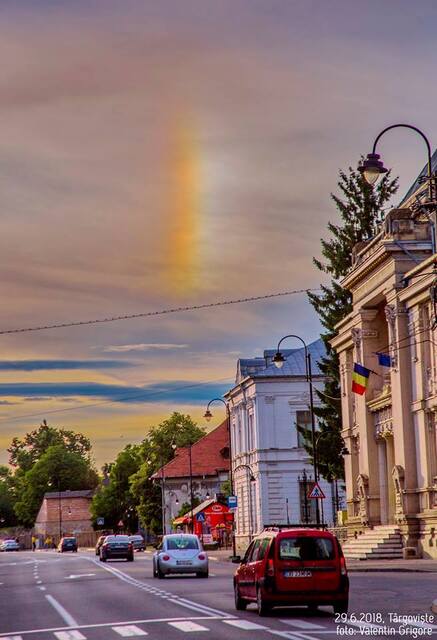
“If the world could hear the voices of the stars
Humanity would be better.”
-Valentin Grigore-
 800.jpg)
 800.jpg)
 800.jpg)
These introductory photos by Valentin Grigore in 2018 include:
a sundog on the Monarchical Way in Targoviste,
near the Dambovita History Museum,
chosen by the president of SARM for the site of
Targoviste International Astro-Fest 2018;
sequences from SARM’s Perseid Event 2018,
an annual meeting launched in 1993 in Targoviste
and moved later to other Romanian locations,
that gave birth to
a revolution in Romanian amateur astronomy.
I had adorned the last three with haiku poems:
thus transforming them into works for our project,
Skies of Romania
(100 astro-haiga dedicated to the Centenary Year of the Great Romanian Union),
that we published in the Astropoetry Blog of Astronomers Without Borders
during 2018
(the difference consisting of a larger resolution here,
in the Targoviste Astro-Fest web chronicle).
AWB has been an excellent host
for the SARM Astropoetry-Cosmopoetry initiatives since 2010.
Just like in a cosmic law of compensation,
in October 2018,
SARM hosted important personalities and representatives of AWB
from four continents,
including the founding president,
at the Astro-Fest in Targoviste
that featured:
a national astronomy festival
with participants from the Republic of Moldova - formerly part of
Romania’s Basarabia (Bessarabia) province - and the Romanian Diaspora;
the first AWB session of live lectures;
a SARM+AWB Cosmopoetry Program.
Targoviste was Capital City of the Romanian Land of Wallachia.
Currently it is “Capital City” for astronomical events in Romania.
It also
hosts the Headquarters of SARM.
So here are a few astro-haiga with this city under the free sky,
created by Valentin Grigore (astrophotographer) and myself (astropoet)
since 2018
(first published in AWB’s Astropoetry Blog,
at a smaller resolution).
 800.jpg)
 800.jpg)
 800(1).jpg)
 800.jpg)
 800(1).jpg)
And here are
three pictures from Targoviste International Astro-Fest 2018,
taken by George Tanase.
In the last of them, from left to right:
Johannes Stuebler (Austria), Roger Hambleton (UAE), Mike Simmons (USA),
Valentin Grigore (Romania), John and Jessica Santascoy (USA),
Andreea Alecu (Romania, guide and translator), Roger Ferlet (France),
John Goldsmith (Australia) and Nicoleta Pasmany (Romania):
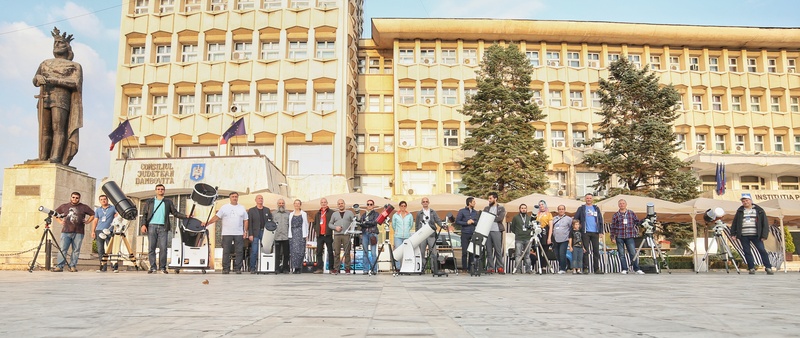
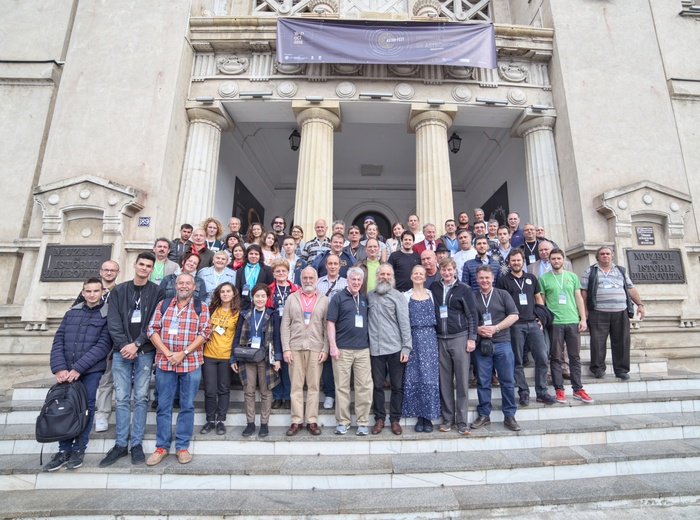
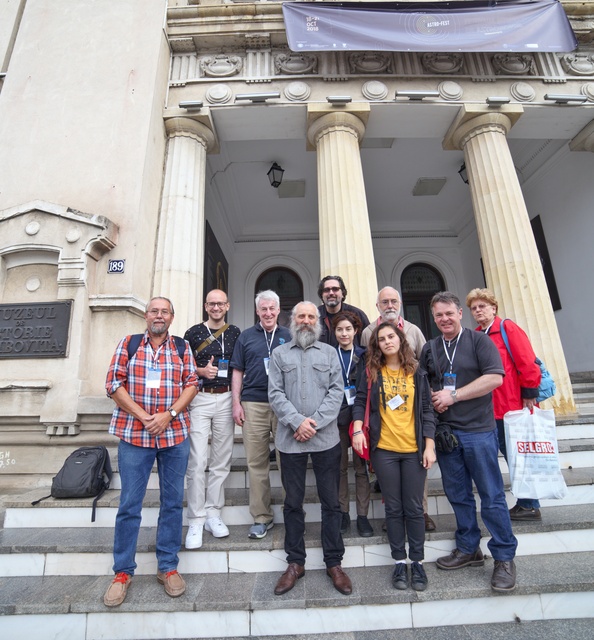
And now, step by step,
the story of the event.
*
Since funds for this festival were approved only three weeks earlier
from the Youth Ministry,
the Targoviste Mayoralty and the Dambovita County Council,
it was clear we had a lot of work to do in a very short time.
Inspired in Bucharest by the Sun and the Moon,
the two heavenly bodies reproduced on the old Wallachian coat of arms,
I did my best to contribute to
Targoviste International Astro-Fest 2018,
an event dedicated to the Centenary Year of the Great Romanian Union
and to the 25th anniversary of SARM.
…And I went off to Targoviste.
DAY ONE: OCTOBER 17, 2018
I arrived in Targoviste at noon.
In the Wallachia Hotel, I remarked on
an interesting painting-collage with personalities from the city,
at a nearby restaurant
I had lunch with the first group of participants,
and later at the Dambovita City Council
I enjoyed the kindness of its secretary,
Mr. Ivanov (a founding member of SARM),
who told us about points of interest in the area.
Then the participants strolled along the old streets of the city.
To reproduce the local atmosphere,
here are a few other astro-haiga
Valentin and I made in 2018.
 800(1).jpg)
 800(1).jpg)
 800.jpg)
But I preferred to hunt alone for the sunset over the Targoviste City Hall,
near the statue of Constantin Brancoveanu
(a former ruler of Wallachia in the 1700s
and martyr of Christianity)…
Crepuscular rays -
palpable dimension of
the impalpable
-Andrei Dorian Gheorghe-
Through the window of the hotel
I saw the statue of Mircea the Elder,
who was victorious over the Ottoman Sultan Bayezid
at Rovine in 1394.
He stopped the Ottoman advance into Europe
and decided the future of Wallachia for a few centuries -
not a pashalik, but a tributary state of the Ottoman Empire.
The Moon over the central square
and I started to the dinner.
DAY TWO: OCTOBER 18, 2018
“Break in clouds -
the Creator’s hand
weaves light”
-Iulian Olaru-
After sunset I went to the Dambovita Museum of History
(seat of the Astro-Fest)
to help with the finalization of the exhibition
(arranged by a group of SARM volunteers,
led by George Ianculescu and Cosmin Sorin Miclos)
and to listen to the lectures.
Now I have to confess that I didn’t expect
to become a chronicler of an event
with such an impressive national participation:
representatives of planetariums and state and private observatories
(Galati, Barlad, Suceava, Constanta, Horodnicul de Jos, Vega),
astronomical associations (AREA, Astronomer Disciple, Sirius, Urania,
the Hungarian Astronomical Association of Transylvania),
astroclubs (Bucharest, ORION-Tulcea, Meridian Zero-Oradea,
Orion-Luteni Iasi, SARM Gorj, Orion Junior-Pitesti, Astronauticus-Mangalia),
the Astronomical Institute of Romanian Academy,
ESERO (European Space Education - Romania)
and other national institutes (for Earth Physics, for Space Science,
for Laser, Plasma and Radiation Physics),
the magazine “Stiinta si Tehnica”, Craiova University,
the Romanian Society for Cultural Astronomy,
Research X Development (3D), the National Naval Academy,
CRESTEM (the Association for STEM Creative Education)
and contributors to the EURONEAR project
(led by Ovidiu Vaduvescu from the Canary Islands,
this project discovers asteroids
and names them after Romanian personalities in astronomy).
So perhaps some may find a few inadvertences in my next photo-comments,
but nobody is perfect.
Anyway, I understood then that
Targoviste International Astro-Fest 2018
was a historical event
and can remain an inspirational model for anybody.
I also have to confess that initially
I opted for foggy-colored visions of Camy 2 (my second camera).
The ambient was dominated by the numerous pictures of Valentin Grigore,
admirably completed by those of Attila Munzlinger
(the last great laureate for astrophotography in Romania),
Babak Tafreshi (Iran, leader of the international elite group
of astrophotographers The World At Night, affiliated to AWB),
Emil Pera (national and international laureate for DSO astrophotography)
and others.
But first I enjoyed an old painting at the museum
with Mircea the Elder (the founder of the city in the 14th century)
among the stars.
Bright people and stars -
there’s no border but just a
joint sense of light
-Andrei Dorian Gheorghe-
Nicoleta Pasmany from the Oradea Meridian 0 Astroclub
had an exhibit of astroart and astrophotography by her students
culminating with Nelu Rugan,
while Sofia Ghiga (age 9) from the Pitesti Orion Junior Astroclub
exhibited a few astropoems.
Dimitrie Olenici from the Suceava Planetarium
made an international mini-exhibition of astronomical calendars,
and another one at the Dambovita Library
(photographed by Valentin Grigore)
with astroart and astronomical cahiers (essays and poems)
by Romanian children who had participated
during their annual Equinox national festival in Suceava.
When I was a child,
envious of the adults
who could fly in rockets,
I dreamed to dance
with comets.
Now I am an adult,
envious of the children
who dream to dance
with comets…
-Andrei Dorian Gheorghe-
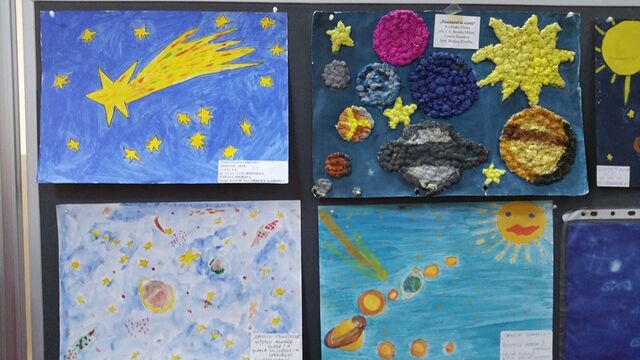
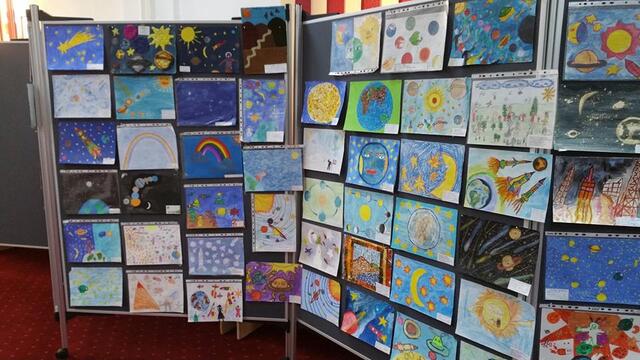
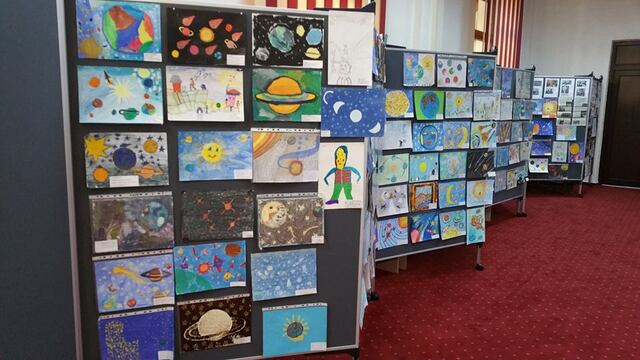
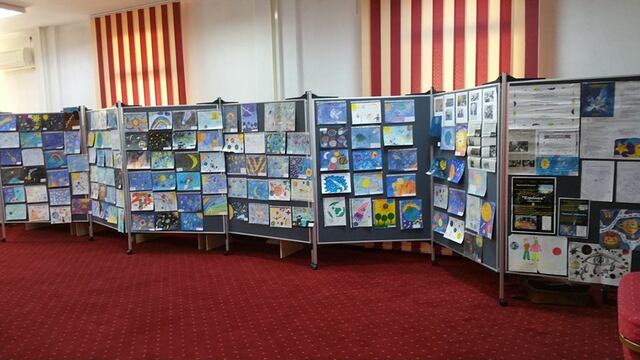
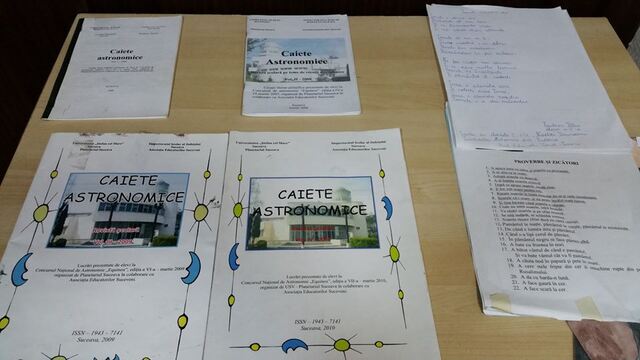
There were also three foreign posters:
one of the Linz Astronomical Society,
dedicated to the 400-year anniversary since Johannes Kepler
announced the 3rd law of planets;
one of AWB,
presenting various activities, from international cooperation
to astrophotography and sidewalk astronomy;
one from the International Dark Sky Association,
about stopping light pollution.
Usually, the lectures take place in English
or in Romanian with projections in English;
the event had a translator on duty,
Cristian Danescu (technical vice-president of SARM
and astronomer at the Astronomical Institute of Romanian Academy).
The first session was dedicated to
the Great Romanian Union (1918-1920):
I spoke about astronomers connected to the Romanian Unions
(1859, 1877-78, 1918-20;
including
Neculai Culianu, Constantin Capitaneanu, Stefan Hepites, Constantin I. Bratianu,
Vasile Urseanu, Nicolae Coculescu, Spiru Haret, Nicolae Donici,
Constantin Parvulescu, Gheorghe Demetrescu and others,
culminating with Victor Anestin,
founder of the first Romanian astronomical society in 1908
with leading members not only from the Romanian Kingdom
but also with Romanians from the Austro-Hungarian Empire
(practically a proto Great Romanian Union through astronomy);
the president of the Romanian Association for Education through Astronomy,
Erika Lucia Suhay
(in cooperation with Magda Stavinschi,
former director of the Astronomical Institute of Romanian Academy)
spoke about two illustrious astronomers,
Constantin Parvulescu and Gheorghe Demetrescu,
who fought in World War I;
Vitalie Chistol (from the Republic of Moldova,
director of the Chisinau Observatory)
about the “Einstein of Basarabia,” Nicolae Donici,
a great Romanian astronomer
whose memory is disputed today by France, Russia, Moldova and Romania;
Dimitrie Olenici about the astronomical symbols
from the Tablets of Tartaria
(the first form of writing, approximately 5,000 BCE)
and their continuity in symbols on Romanian houses;
Marian Naiman, president of the Bucharest Astroclub,
about the activities of this elite club
(scientific projects - especially on variable stars -, camps,
popularization, astrophotography).
After the lunch break, the second session:
Octavian Blagoi (from the Bucharest Astroclub,
also working for the Astronomical Institute)
talked about the “piston” altazimuth mount;
Marcel Jinca (leader of the SARM Gorj Astroclub)
presented his astronomical books
(from amateur astronomy to ephemerides);
Jan Ovidiu Tercu, coordinator of the Galati Observatory,
discussed the activities of this observatory,
culminating with the discovery of a few variable stars and an asteroid;
he also gave a moment of astroart
(a succession of images with the telescopes of his observatory
set to music);
Nicoleta Pasmany spoke about astronomy in the Oradea fortress,
seat of the Prime Meridian in the 15th century,
where today she leads the Meridian 0 Astroclub;
Dimitrie Olenici presented his rosette of the Saros circle
of solar eclipses;
Cristian Danescu presented his space-temporal vision
on the evolution of the deep sky objects;
Laurentiu Dinu and Daniel Ghinea
made a 3D printing demonstration in astronomy;
Dragos Tataru from the Institute for Earth Physics
told about seismometers as modern cosmic explorers;
Andrei Pocora from the Naval Academy
spoke about astronomy in training marine officers.
The last session of the day was dedicated to films:
“The Carol of a Lunar Cosmonaut”,
a 2002 SARM videoclip directed by Gelu Claudiu Radu,
with Dan Mitrut performing astro-folk music;
“The Borderless Sky, the Aboriginal Sky in Australia”,
a 50 minute production from Taglicht Media,
based on an astro-cultural-photographical expedition of John Goldsmith
to Western Australia,
who also presented here a sensational album of astrophotography
on the Southern Sky,
“The Universe - Yours to Discover”,
edited by himself and produced by Celestial Visions.
Then, in the real sky,
the sunset and a conjunction.
Even under light pollution
The Sun goes to sleep
When the Moon and Mars
Are suppliers of stars.
-Andrei Dorian Gheorghe-
DAY THREE: OCTOBER 19, 2018
First I went to the statue of Vlad Tepes Dracula
(victorious over Mehmed the Conqueror
during a night attack near Targoviste in 1462),
near the history museum.
Then I saw Valentin Grigore
approaching the museum.
So… let’s start!
Inside, I enjoyed three remarkable lectures:
Ciprian Vintdevara,
coordinator of the Barlad Observatory,
spoke about his extraordinary discovery of a red nova
(only the seventh in history!);
Gabriel Corban
from the Bucharest Astroclub,
the national laureate for solar and lunar astrophotography
(and recipient of an award from the British Astronomical Association),
presented his work in astrophotography,
as did Attila Munzlinger
from the Magyar Astronomical Association of Transylvania,
the great national laureate for astrophotography in Romania,
specializing in landscapes.
Then, I presented my lecture
on SARM Astro-Humanist Activities.
Obviously, I climbed to the floor of the museum
to see their pictures and those of Maximilian Teodorescu
(international laureate for the Lunar Astrophotography of the Day),
among mantles of old Romanian rulers
(“voievods” and “domnitors”).
With the lecture by Mirel Barlan about spectroscopy of asteroids
(which I caught between two short breaks
while photographing two historical buildings
visible from the courtyard of the history museum)
I decided to use the clear-luminous visions of Camy 3
(my third camera).
Mirel Barlan is the president
of the Romanian National Committee for Astronomy,
working at the Paris Observatory in France.
An asteroid was named after him in 2003;
and also
the International Astronomical Union named an asteroid:
Romania (!),
after his recommendation.
And now, aspects from the first live session of lectures
from Astronomers Without Borders,
organizer,
during the International Year of Astronomy,
of the largest ever world astronomical festival in 2009,
100 Hours of Astronomy
(around 2,400 events in 100 countries,
among which SARM organized in Targoviste “the second largest event”).
of the Annual Global Astronomy Month since 2010,
and of many other projects,
coordinating them on-line
and internationally unifying the activities
of celebration and popularization of astronomy.
Here is a resume of those historical moments
in Targoviste International Astro-Fest 2018:
Mike Simmons (founder president of AWB, coming from Los Angeles;
an asteroid is named after him, too)
gave a complex lecture, “One People, One Sky”,
on the activities of this organization;
Audrey Fischer (former president of the Chicago Astronomical Society,
founder of “One Star At A Time” and the “Global StarPark Network”,
consultant on light pollution for AWB)
gave an impressive lecture, entitled “Blue Light at Night”,
about the necessity and the methods to have a clean sky;
Johannes Stuebler (AWB international ambassador
and national coordinator for Austria;
together with his wife, Ulrike, often travel
to other countries to popularize astronomy,
their microbus being decorated with astronomical symbols)
from the Linz Astronomical Society
dedicated a lecture to the older hometown fellow Johannes Kepler,
ended with a picture of his house,
that became NASA’s Astrophotography of the Day;
John Goldsmith (Celestial Visions producer
and member of AWB’s “The World At Night”)
talked about astronomy in Western Australia
and their annual Astrofest.
Roger Ferlet (emeritus Director of Research at
the Paris Institute of Astrophysics,
professor at Sorbonne University,
vice-president of the French Astronomical Society
and French representative for AWB)
spoke about advanced astronomical activities in France.
Roger Hambleton (AWB national coordinator for UAE;
was born in Canada and has Polish roots)
gave a lecture on astronomy and space exploration in the Emirates.
A short walk through the nearby Chindia Park,
with views of ruins of the former Targoviste Monarchical Court,
destroyed in 1716 by order of the Ottoman sultan.
To watch Dracula’s
Tower becoming just a
tower of the Sun!
-Andrei Dorian Gheorghe-
The Gala Session filled the floor of the museum
with children from more local schools,
who enthusiastically greeted the speakers
(accepting special awards from SARM through its founder president,
Valentin Grigore):
Cosmonaut Dumitru Prunariu (the 103rd astronaut in history,
who flew with a Soviet mission in 1983),
Alexandru Mironov (popularizer of sciences
and former Minister of Youth in Romania),
along with
Mick Simmons, Audrey Fischer, Johannes Stuebler, John Golsmith,
Mirel Barlan and Vitalie Chistol.
Their group photos also include
Roger Humbleton (Cabada-EAU), Jessica Santascoy (USA)
Greg Fischer (USA, amateur astronomer
and president of Wild Blossom Meadery & Winery),
and Moldavians Stefan Tiron and Ion Nacu.
That afternoon, the Astro-Fest
moved to the central square for an open air section,
inaugurated by the special guests
and honored by a speech from Dumitru Prunariu,
with the public at large.
George Tanase took a few pictures
from the astronomical stands.
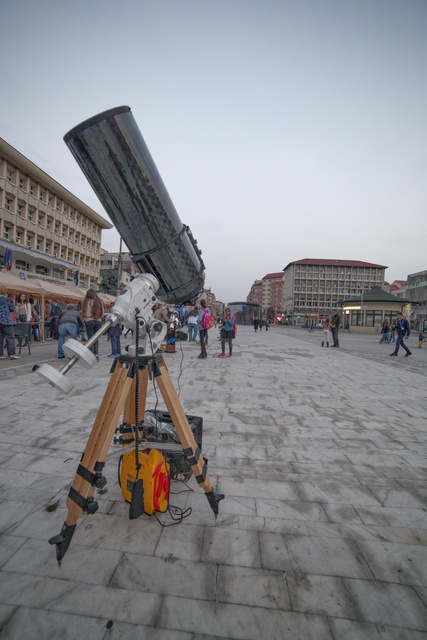
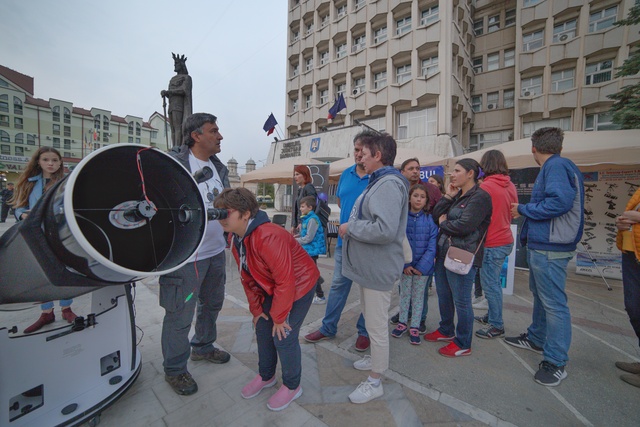
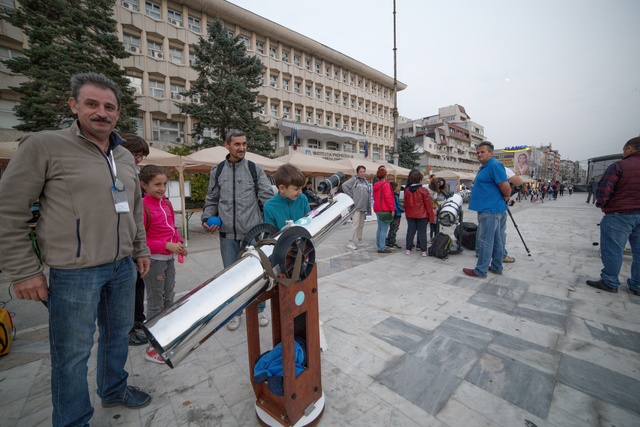
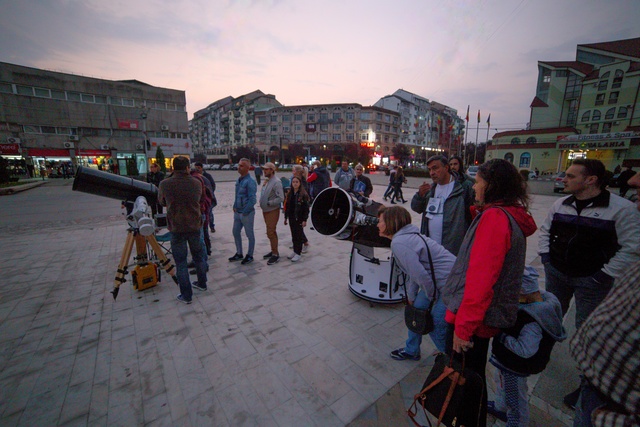
Before the evening session I also toured the stands,
and I commented at the “army” of telescopes installed by
the Urania Astronomical Association and AstroLife, the Bucharest Astroclub,
the Magyar Astronomical Association of Transylvania and Telescop Expert.
Other stands were made by
SARM, national institutes
(for Earth Physics, for Space Science, for Laser, Plasma and Radiation Physics),
CRESTEM, the Romanian Society for Cultural Astronomy,
and I also saw
books by SARM Gorj Astroclub
(written by Marcel Jinca),
astronomical souvenirs from SARM
(including a mug with the Astro-Fest logo,
made by Alexandru Sebastian Grigore),
and a stand from the Chicago Astronomical Society
and the International Dark Sky Association,
where Audrey Fischer gave astro-presents (including star costumes)
to children.
I also saw
the president of Urania, Dragos Brasov,
the most active eclipse hunter in Romania, Catalin Beldea
(double laureate of NASA’s Astrophotography of the Day),
and Ferenc Szende from Telescop Expert.
During the last session of the day,
two contributors to the EURONEAR project, the Boldea husbands
(Afrodita and Radu, from the Craiova University) talked about asteroids,
while Paul Gidei launched the new issue of
the “Pasi spre Infinit” (Steps toward Infinity) magazine,
and presented an award to SARM from the Sirius Astronomical Association
(led by Ioan Adam).
Shortly before midnight, from the window of the hotel,
I saw the Moon over the bright lights of the square.
Sometimes the Moon shows
that not anyone deserves
to carry a crown
-Andrei Dorian Gheorghe-
DAY FOUR: OCTOBER 20, 2018
Going to the History Museum on the Monarchical Way,
I remembered that Valentin Grigore had taken a photo there
with a solar halo a few months ago,
which we transformed into another astro-haiga.
 800.jpg)
The last session of the Astro-Fest included lectures on astronomical education,
given by Stefan D. Tiron (from the Chisinau Academy of Sciences)
and teacher Ion M. Nacu, both from the Republic of Moldova,
and teachers Ioana Camelia Ghiga and Daniela Florentina Ilesan,
while Marc Francu from the Romanian Society for Cultural Astronomy
made an archaeo-astronomical presentation based on his book, “The Circle of Stone”.
The last lecture belonged to Valentin Grigore,
with a presentation of SARM’s history and achievements,
starting in 1993 from meteor observations
and expanding to many other fields,
promoting a special concept, astronomy-culture-art-education-society,
and serving in many cases as the national astronomical society in Romania.
From then on, George Tanase became the photographer for the event
(however, I still completed him a few times),
while Valentin Grigore made the pass to the Cosmopoetry Show.
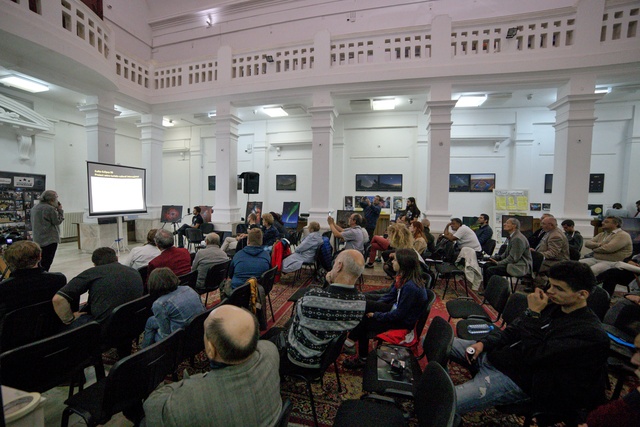
After tens of SARM’s festivals, galas, shows, exhibitions, demonstrations
and short presentations of cosmopoetry in Romania,
an International Cosmopoetry Festival in English
(Targoviste 1999, during SARM’s EuRoEclipse Perseids 99 event),
fifteen astropoetry shows at the International Meteor Conference (1997-2011),
an astropoetry show at a NASA Workshop
(Leonid MAC Campaign, Tel Aviv 2000),
another one at an European Convention of Science Fiction
(Capidava - Atlantykron, 2001),
another one at a Symposium of the International Astronomical Union
(UNESCO-Paris 2009),
another one at an International Dark Sky Parks Symposium
(Monsec 2011)
and a show of international astropoetry during
the world festival of the Galilean Nights (Targoviste 2009,
part of SARM’s local event which won the Outstanding Award),
on October 20, 2018, I had the chance to coordinate
an original AWB & SARM Cosmopoetry Show.
(In our vision,
cosmopoetry = astropoetry in combination with other arts).
And because SARM is part of AWB,
we can say it was the first live cosmopoetry show of AWB,
and was developed in the English language,
with a few exceptions.
(However, it was a little strange for me to come back
to an international astropoetry-cosmopoetry show
seven years after the last one,
at the 2011 International Meteor Conference in Sibiu;
that’s why I didn’t dare to risk too much this time,
preferring to combine old available moments with new ones.)
The spectacle began with Valentin Grigore and I
reading the two mottos of SARM, both in Romanian and English;
the first initially launched for SARM’s annual Perseid Event in 1993,
while the second for SARM’s Cosmopoetry Festival in 1996.
“Admirați împreună cu noi
splendorile cerului înstelat.
Priviți lumina stelelor şi descoperiți
pe Cel Ce A Creat Lumina.
Come with us to admire
the splendors of the starry sky.
Look at the bright stars and discover
He Who Created the Light.”
-Valentin Grigore-
“Intrând în Casa Universului
Apar conexiuni fireşti,
Cu stelele când stai de vorbă
Trebuie sa străluceşti.
In the House of the Universe
Say: It’s mine!
But, talking to the stars,
You must shine.”
-Andrei Dorian Gheorghe-
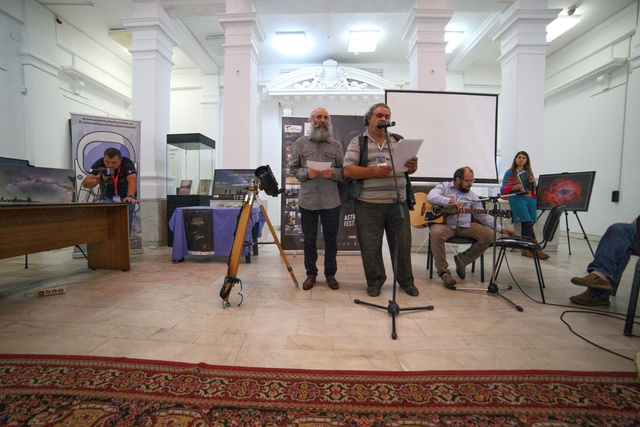
Dan Mitrut,
the the most complex Romanian astroartist
(poet, painter, sculptor, dramatist, philosopher, mythologist,
actor, computer artist and musician)
performed his song, “Rain of Stars”, in Romanian
(launched in 1997),
a veritable hymn of SARM,
from which I translated a few significant verses for the foreign spectators.
“It’s raining stars over the blind Earth.
It’s raining stars bathed in milk.
Chains of the night rattle in the sky.
Maybe these are mysteries
For which we cannot find words,
Maybe it’s a meteoric, sublime destiny
From the Sun.”
-Dan Mitrut-
I read a stanza from an astropoem I had written in 2018:
“Probably a superior love
Pushes the sky watchers to jump
From the terrestrial vanity
To the universal adventure.”
-Andrei Dorian Gheorghe-
The director of the Chisinau Observatory, Vitalie Chistol,
recited three stanzas from a famous astronomical poem by Mihai Eminescu
(the national idol in two contemporary states,
Romania and the Republic of Moldova,
and a prophet of the Great Romanian Union),
La Steaua - To the Star (written in the 1880s),
from which I translated only one stanza:
“La steaua care-a răsărit
E-o cale-atât de lungă
Căci mii de ani i-au trebuit
Luminii să ne-ajungă.
Poate demult s-au stins pe drum
În depărtări albastre
Iar raza ei abia acum
Luci vederii noastre.
Icoana stelei ce-a murit
Încet pe cer se suie,
Era pe când nu s-a zărit,
Azi o vedem şi nu e.”
-Mihai Eminescu-
“The icon of the star which died
Is slowly climbing in the sky.
It was when we did not see it,
Today we see it, but it is not.”
-Mihai Eminescu in ADG’s translation-
I read a haiku from my friend Bob Eklund (USA),
editor of AWB’s Astropoetry Blog,
who had sent it to me a few days ago for this show:
Seeing together
The new winter stars tonight
Over us
-Bob Eklund-
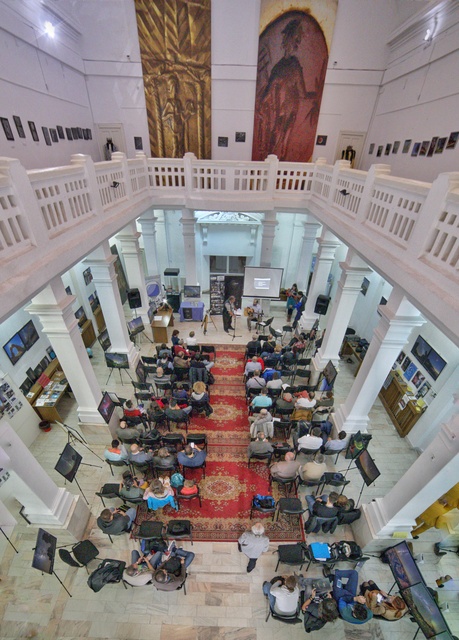
Alexandra Pocora read her astropoem:
Andromeda is singing
The walls of the sky tremble in the wake of her voice
Making Earth and its moon rumble
The dissipation of her voice,
Contagious.
Borders are no more.
In anticipation of something big that’s about to happen
The man stands tall.
Hands join other hands,
Heads bump into other heads
While heading for that place
Where the future lays.
Collide?
Unite?
Maybe all the same...
Then silence endures
100 years over Wallachia.
-Alexandra Pocora-
I performed my favourite astro-tipuritura
(replacing the drinks - wine with beer)
in Romanian and English:
(tipuritura is the shortest Romanian poetic form,
created in the Maramures-Oas zone):
“Trăiesc în Calea Lactee,
Dar din bere-aş face-alee.
I live in the Millky Way,
But some beer would be OK.”
-Andrei Dorian Gheorghe-
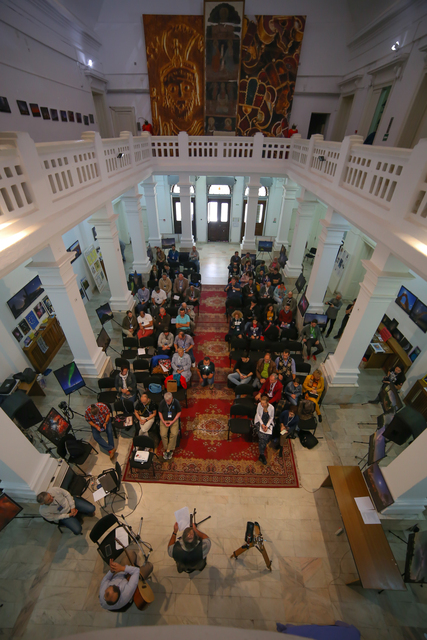
Dan Mitrut performed another song,
“Floare, Floare de Cicoare,
Care-i drumul către Soare?
Flower, Chicory Flower,
What is the road toward the Sun?”
for which his wife, Ioana Mitrut,
made a short literary-mythological analysis in English.
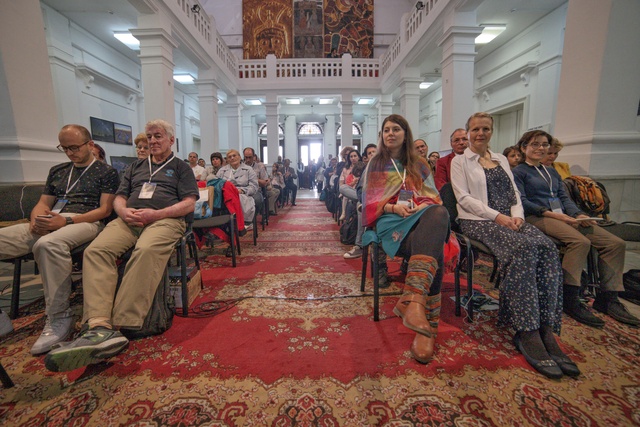
I read a stanza which I had written especially for the show:
Astronomers will always find
Another new border
And will liberate it soon
Serving the stellar order.
-Andrei Dorian Gheorghe-
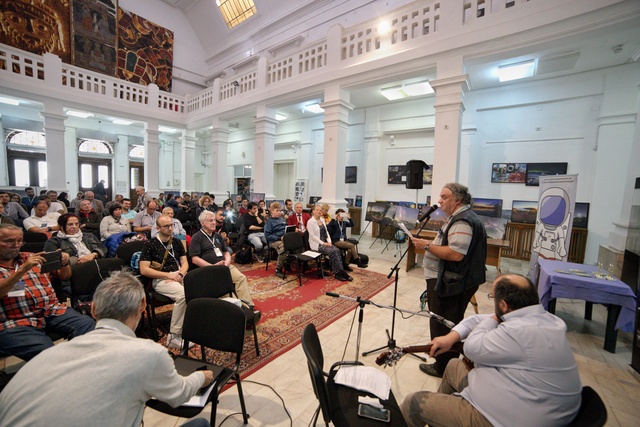
The founding president of Astronomers Without Borders,
Mike Simmons (USA),
gave a speech about creativity in this world organization.
With rare modesty,
he tried to reduce his obvious merits of coordination,
praising the people with constructive ideas
and talking about the evolution of the Art and Culture programs
and the Astropoetry Blog.
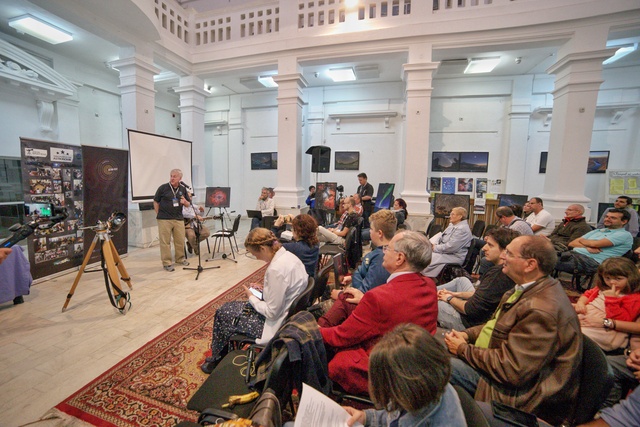
A lovely surprise was Sofia Ghiga (age 9),
who read two astropoems:
CREATIVE SPACE
This is the creative Cosmos,
whales fly through space,
tortoises turn round the cloud of a nebula,
colored planets float,
comets are agitated,
stars become bigger…
I collect supernovae.
Someday they will explode.
-Sofia Ghiga-
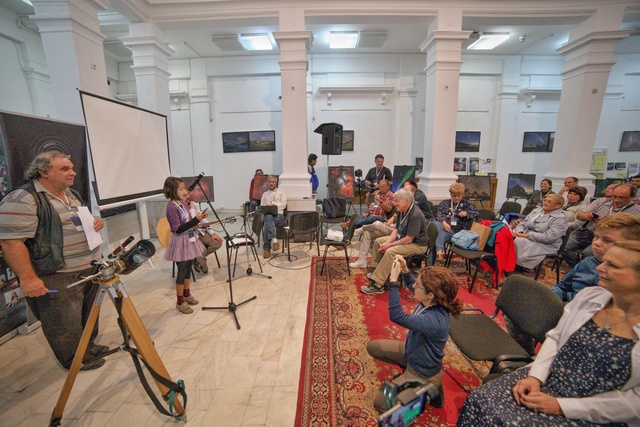
MOON
The Moon is upset with Phobos and Deimos.
Phobos is too boring,
while Deimos is too capricious.
That’s all.
After a study,
they will disappear after 30,000 years.
Until then, they dance in peace
with the stars.
-Sofia Ghiga-
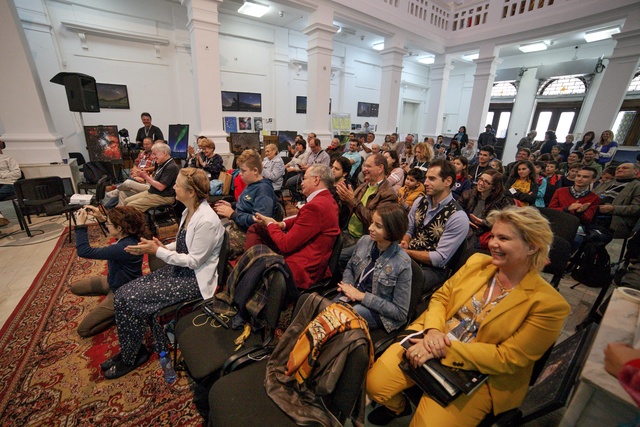
A great lady of the fight against light pollution,
Audrey Fischer (USA),
founding president of “A Star At A Time”,
talked about the virtues of a clean sky
for education, culture and creativity.
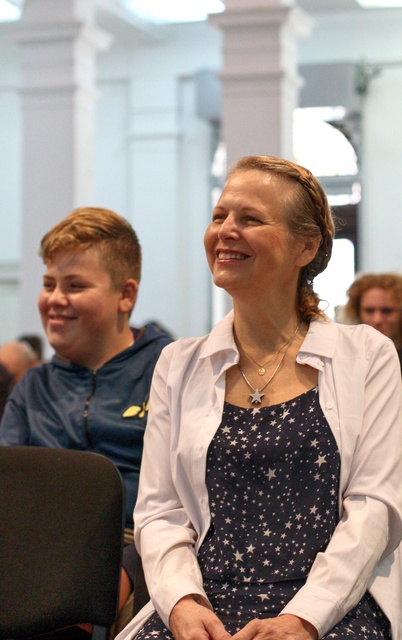
Dan Mitrut performed a third song in Romanian,
“The Ballad of an Aperiodical Comet”,
from which I translated a few lyrics:
“Heart of ice,
Return to life again,
Give me back the wonder that I lost,
My way and the longing for Earth.
Remember your perihelion
Toward my planet,
Traveler on the drop of a star.
Remember your road back
And remain always in our sky.
Immortality… is not for us!”
-Dan Mitrut-
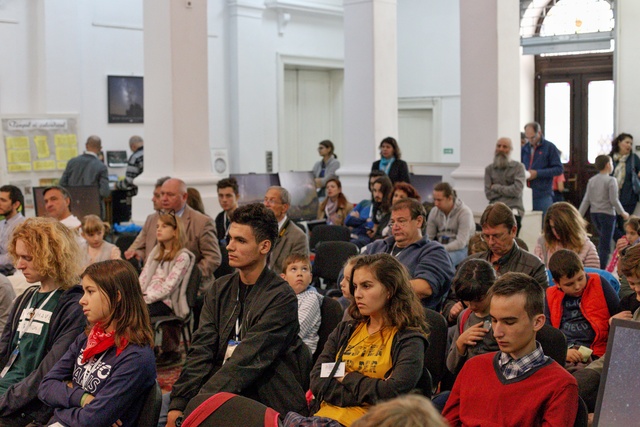
I read three of my old astroproverbs:
“So be it life,
as ponderous matter is enough.
Do not build your house
under the shadow of a solar eclipse.
The meteoroid that cannot enter the atmosphere
says that the planet is not good.”
-Andrei Dorian Gheorghe-
The AWB national coordinator for Austria and international ambassador,
Johannes Stuebler,
read his creed-astropoem, which he uses to perfect every year:
BEING CONNECTED
SITTING ALONE UNDER THE DARK SKY
FAR AWAY FROM CITY LIGHTS
NO STRESS
RELAXING
LOOKING UP TO THE STARS
BEING PART OF THE UNIVERSE
WHERE EVERYTHING BEGAN
STILL BEGINS
AND ALL WILL END.
I BREATHE STARLIGHT
I FEEL CONNECTED MYSELF
CONNECTED TO EVERYTHING
CONNECTED TO ALL
NO BORDERS
SITTING IN OUR ONLY STARSHIP - EARTH
TOGETHER
-Johannes Stuebler (Austria)-
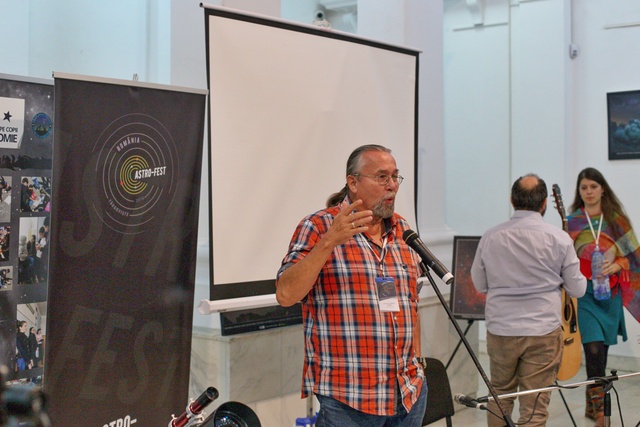
I read a few verses by SARM veterans in astropoetry:
“Who am really I?
Just a star lost in the Universe,
Just a second in a material crevasse,
Maybe a comet crumbled near the Sun,
Maybe a hope for followers.”
-Tit Tihon-
“I know a miracle
as great as the Universe -
it’s a man, it’s me!”
-Dominic Diamant-
“Only through constellations you can see
In the nights adorned by stars
A Swan and an Eagle as two brothers
Peacefully evolving together.”
-Zigmund Tauberg-
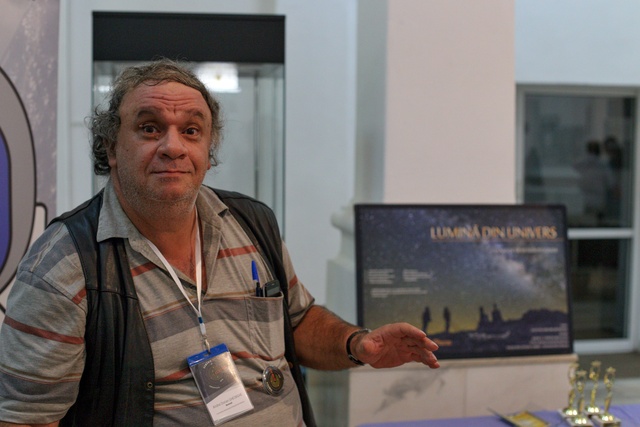
Astronomy Communications & Outreach strategist for AWB
(and social media coordinator of NASA’s Night Sky Network),
Jessica Santascoy (USA),
delighted the audience with the following text (in Romanian and in English):
Astronomers Without Borders iubim Romania
Noi iubim Târgovişte
Noi iubim Cosmopoesia...
Astronomers Without Borders love Romania
We love Târgovişte
We love cosmopoetry…
-Jessica Santascoy (USA)-
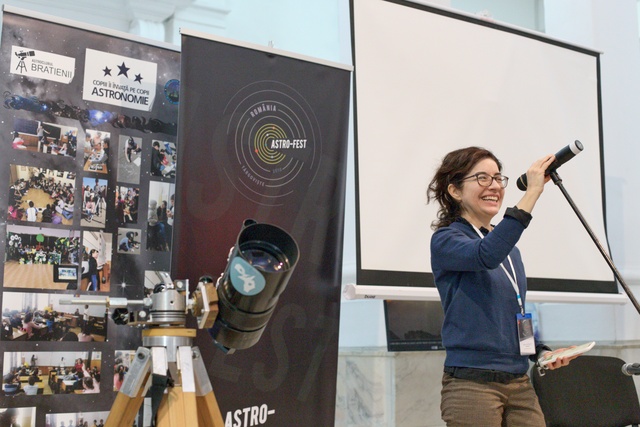
The founding president of the Astronomer Disciple,
Cosmin Sorin Miclos,
read in Romanian and English the motto for his association:
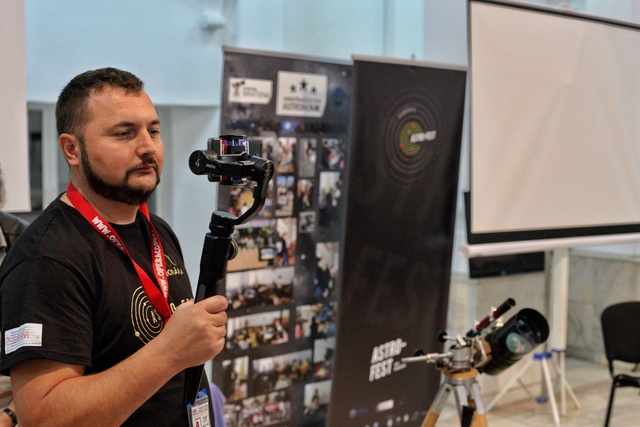
Când stelele răsar în zare
Şi ucenicul s-a trezit,
O singură misiune are:
Întregul Univers de cucerit.
- Cosmin Sorin Miclos-
When stars rise over the horizon
And the disciple is awaken,
He has only one mission:
To conquer the Universe.
- Cosmin Sorin Miclos-
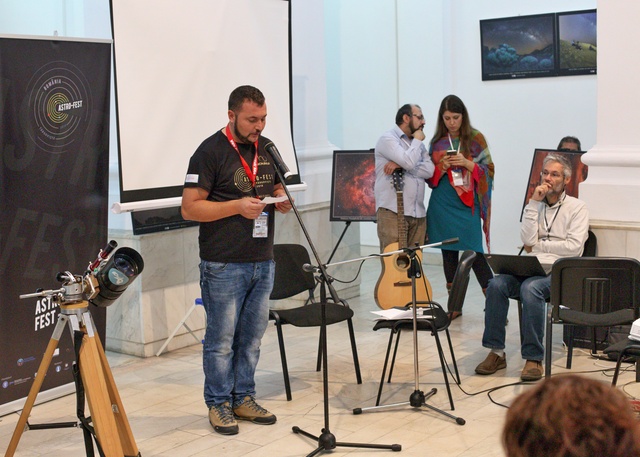
Dan Mitrut performed “Meteor, Destiny of Flight”,
from which I translated a few significant verses:
“Stone with the taste of an evening star,
Give a border to your radiant.
From abysses, from other worlds,
Without wings, the jump is easy,
Meteor, destiny of flight.”
-Dan Mitrut-
I read a few other old astroproverbs:
“Today I don’t have money
So I’ll sell some sunspots
And I’ll buy a few variable stars.
Collecting precious meteorites?
Or dancing with meteors?
My love, for you
I shall look for Polaris
in the southern hemisphere.”
-Andrei Dorian Gheorghe-
The AWB coordinator for UAE,
Roger Hambleton, read a very admired astropoem:
I feel your love
It’s near, it’s far
I feel you here
We share the star.
The star of love
The star of life
I bought a new telescope
Please stay my wife.
-Roger Hambleton (Canada-EAU)-
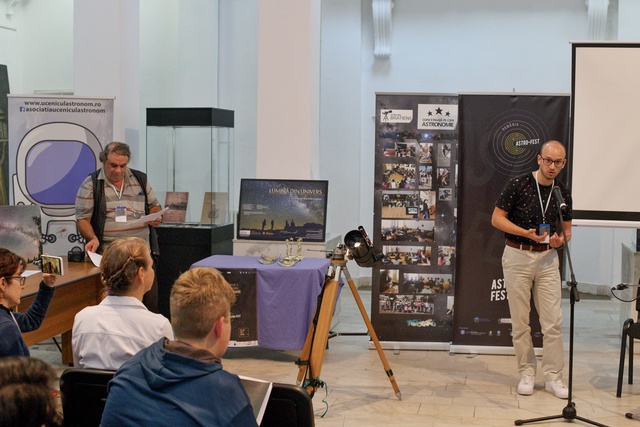
The young guide for foreign participants,
Andreea Alecu (age 17), read her astropoem:
Thorough the telescope
we’re able to see
stars, nebulae
and
galaxies.
but,
Is there something
That we’re
missing
something beyond
our eyes
vision.
New exciting worlds
are waiting to be
discovered.
Worlds far away,
but still close
in our mind,
in our dreams,
Dreams
That may lead
to many discoveries.
Until then,
We’ll keep dreaming.
-Andreea Alecu-
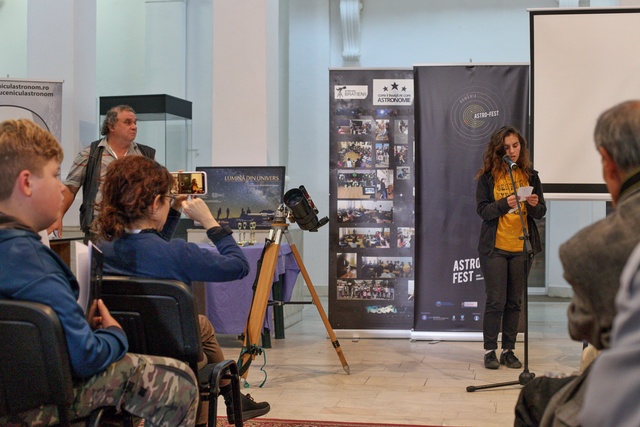
The director for research of the Paris Institute of Astrophysics,
emeritus professor at the Sorbonne University
and vice-president of the French Astronomical Society,
Roger Ferlet,
talked in the French language
about the personality of Camille Flammarion,
the great popularizer of astronomy
and founder of the French Astronomical Society,
who introduced quotations of astronomical verses by classics
in his opera
which has inspired the following generations.
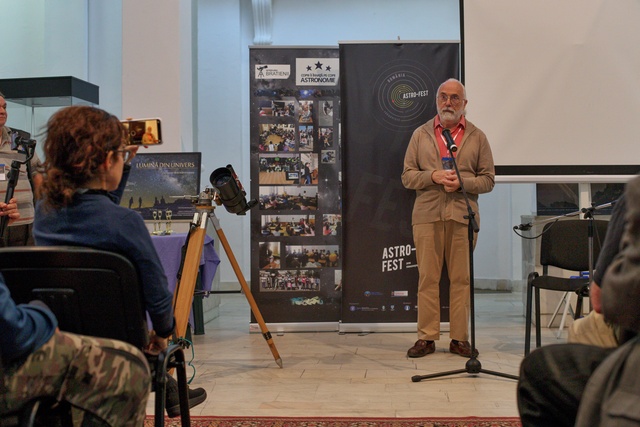
A great lady of Romanian astronomy,
Erika Lucia Suhay
(former president of the Bucharest Astroclub,
president of the Romanian Association for Education through Astronomy,
teacher of mathematics and the most active author of problems
for the Romanian national olympiad of astronomy),
honored me in 1999 with the invitation to write (together with her)
a poetic variant of the famous theorem of the three perpendiculars,
which she launched later in the elite world of Romanian mathematicians.
Now it was the perfect moment to present the same poem
at the cosmopoetry program:
Erika reading it in Romanian
followed by my reading of it in English:
“O rază lungă din steaua Aldebaran
S-a-nfipt chiar perpendiculară pe un plan
Pe baza unui T orizontal taman
Inclus cuminte-n planu-acela pământean.
Şi orice minunată scăpărare-a ei
Căzând oblic pe punctul intersecției
Acelui T, ar fi, prieteni dragi, hai-hui,
O perpendiculară-n capul T-ului.
A long and tender ray from Aldebaran
Came perpendicularly to a plane
Just on a horizontal T’s basis
Included there and seeming like a lane.
And any wonderful spark of that ray,
Falling obliquely - like on a soft bed -
To the T’s intersection point, would be
A perpendicular to the T’s head.”
-Erika Lucia Suhay and Andrei Dorian Gheorghe-
The producer of Celestial Visions,
John Goldsmith (Australia),
read an astro-poem
which he transformed into an astro-photo-poem (cosmopoem) two weeks later,
including images from his recent airplane flights:
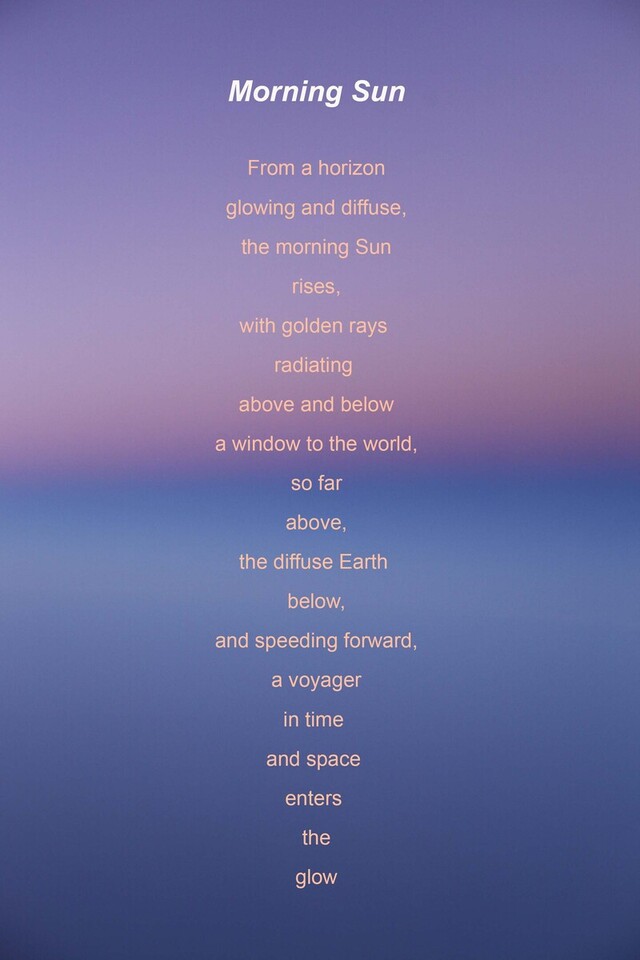
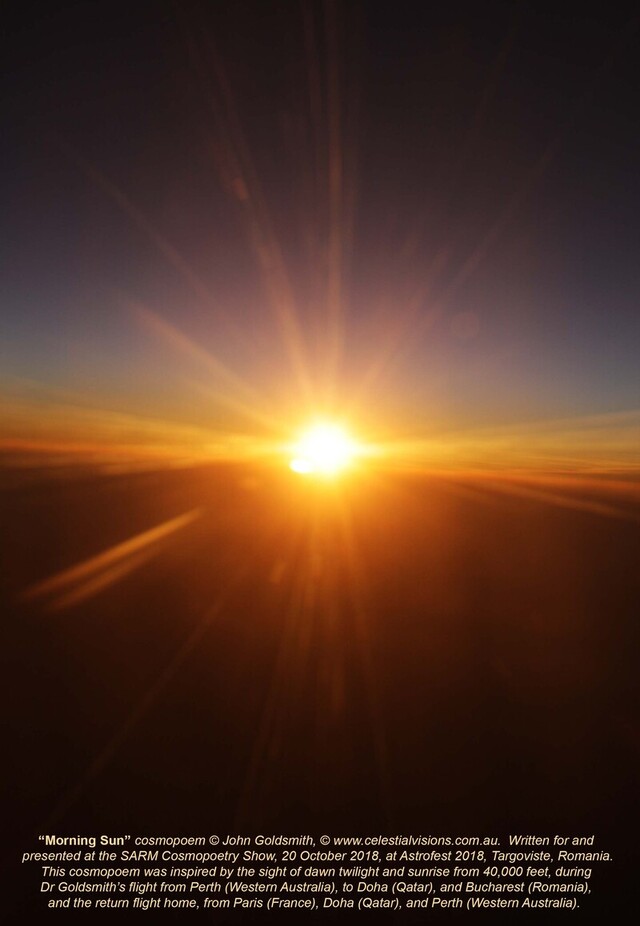
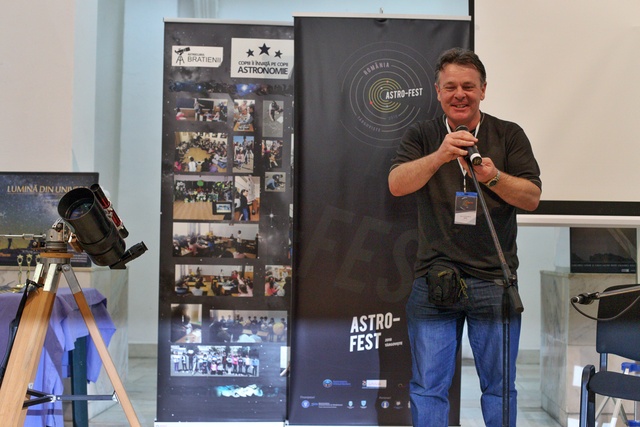
Dan Mitrut performed “It’s Snowing on the Moon”
(or “Carol of the Lunar Cosmonaut”),
from which I translated a few verses:
“Clouds forgotten by the world
Come to Mare Nubium
And begin to snow over
wild, amazed and anonymous rocks.
A cosmonaut, a captive in a costume,
Wants to caress a snowflake.
It’s snowing on the Moon,
It’s snowing like in a dream,
The road toward the Earth is closed.”
-Dan Mitrut-
I performed a humorous astro-sketch,
(my main novelty here)
consisting of five moments.
for which I had written astro-verses
to be used (also by me) on a few well-known musical themes.
For the first theme I used a song from Romanian folklore:
“Let me unfold, let me unfold
To admire the Universe,
But do not let me in flight
‘Cause I can furrow the night.
Let me unfold, let me unfold
To admire the Universe,
But do not let me in flight
‘Cause I’m faster than the light.”
For the second moment I chose an American rock song:
“Welcome to the stars of Ursa Minor,
Such a lovely place, you can live in space,
Plenty a star right in Ursa Minor,
Every time of year, Polaris is here!”
For the third moment I used a theme from Mozart:
“Do you know why the Sun is so bright?
‘Cause the planets just make him all right.
Do you know why the Sun is so rich?
‘Cause on Earth I can go to the beach.”
For the fourth moment I chose a theme from British rock music:
“Meteors fly
Burning in the sky…”
For the last moment of the astro-sketch I chose
a musical theme, Ciuleandra, and a dance, Calusarii,
from Romanian folklore,
and I tried to be chorus, vocalist and dancer:
“Chorus:
Comet, meteor, comet, meteor, comet meteor,
Radiant!
Singer:
I remember Comet Halley
When she went on a sky valley,
Leaving lots of Orionids
And long Eta Aquarids.
And Swift-Tuttle is fine, too,
Leaving Perseids for you.
Temple-Tuttle, did you see
How a Leonid hit me?”
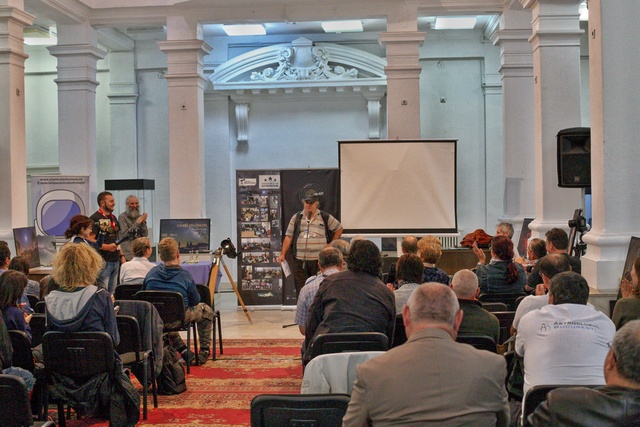
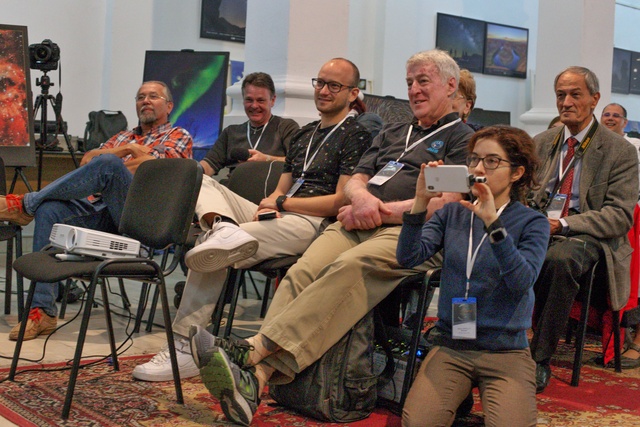
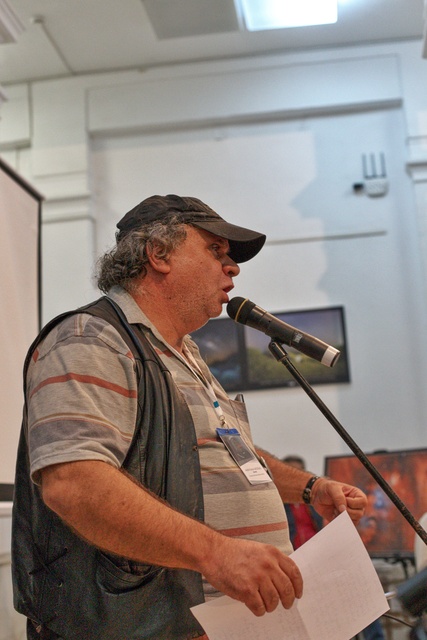
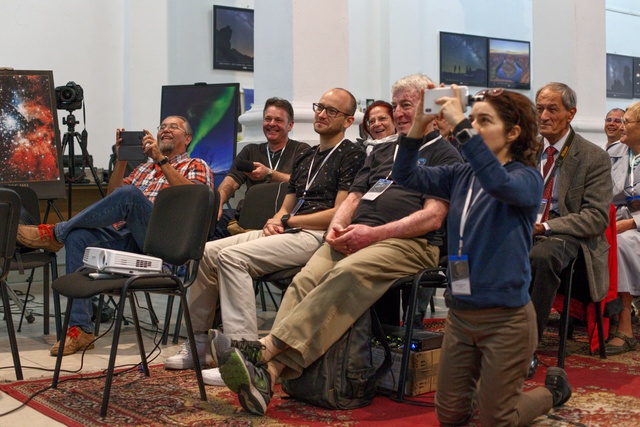
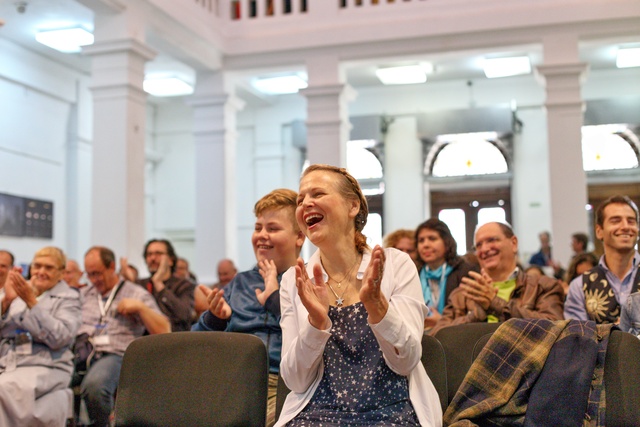
Dan Mitrut performed his last song,
“The Ballad of a Meteor Fallen in Love”,
in which, born close to the stars,
a meteor, poor grain of fire, falls in love
with a mysterious light he sees on Earth;
he thinks she is a star, but finally he finds
she is only a beacon in the night.
Thus, Dan Mitrut enriched his unique series of recitals of astrofolk music
at important astronomical events:
-EuRoEclipse Perseids 99 - Targoviste.
-International Meteor Conference 2000 - Pucioasa;
-SARM’s International Meteor Camp 2004 - Darmanesti;
-Targoviste Galilean Nights Event 2009;
-International Meteor Conference 2011 - Sibiu.
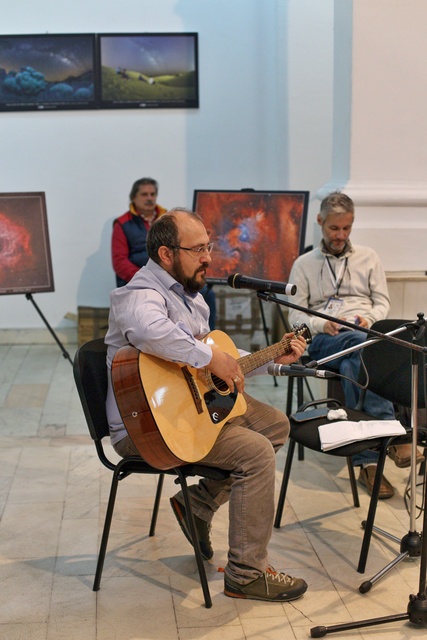
Valentin Grigore came closer to me and, together,
we recited another astro-tipuritura:
Today we feel rich and free
Thanks to you, ASTRONOMY!
Then the last speech of the event belonged to Valentin Grigore,
author and producer of Targoviste International Astro-Fest 2018 concept,
who received a standing ovation and hearty applause,
the main idea he transmitted being:
“The sky brings us together,
it doesn’t have borders
but just an unifying language
which changes us,
so we have to change others
for harmony on Earth.”
-Valentin Grigore-
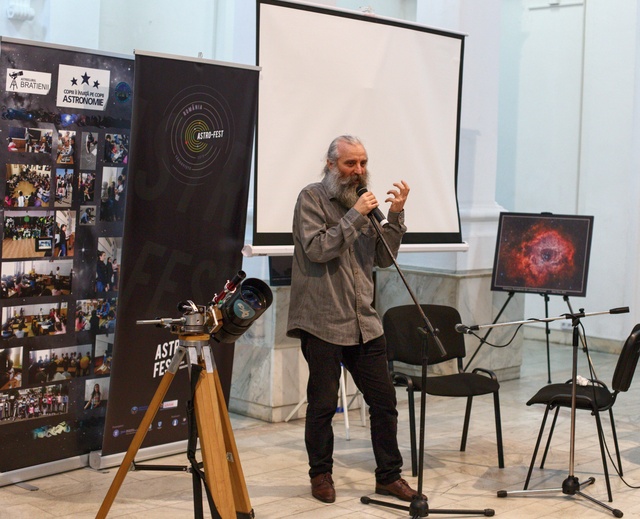
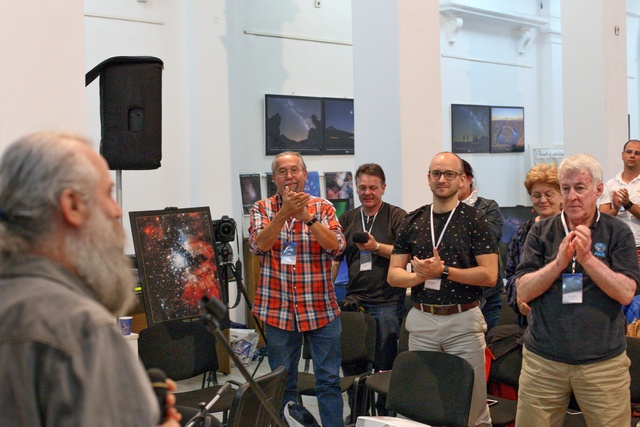
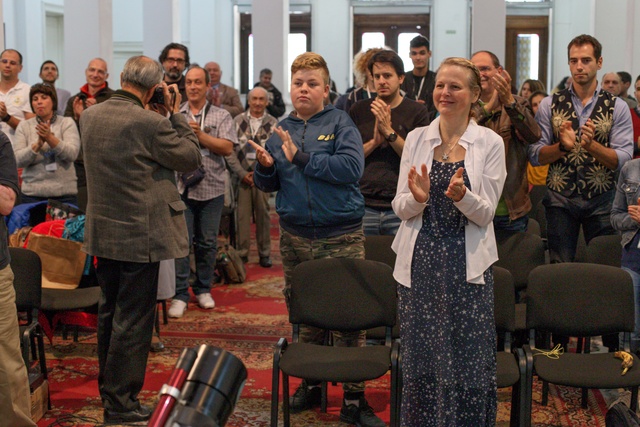
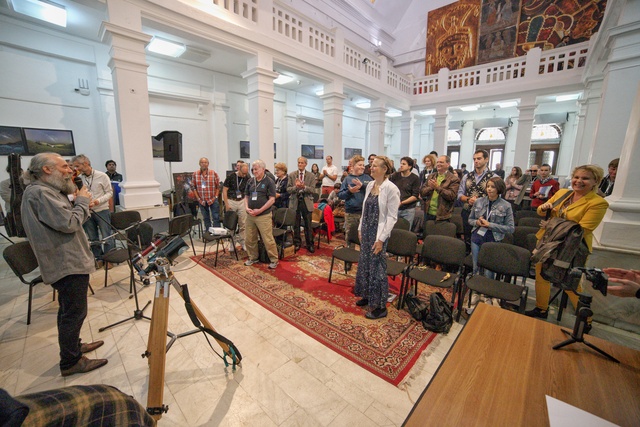
Then a group photo
with George Tanase’s autograph:
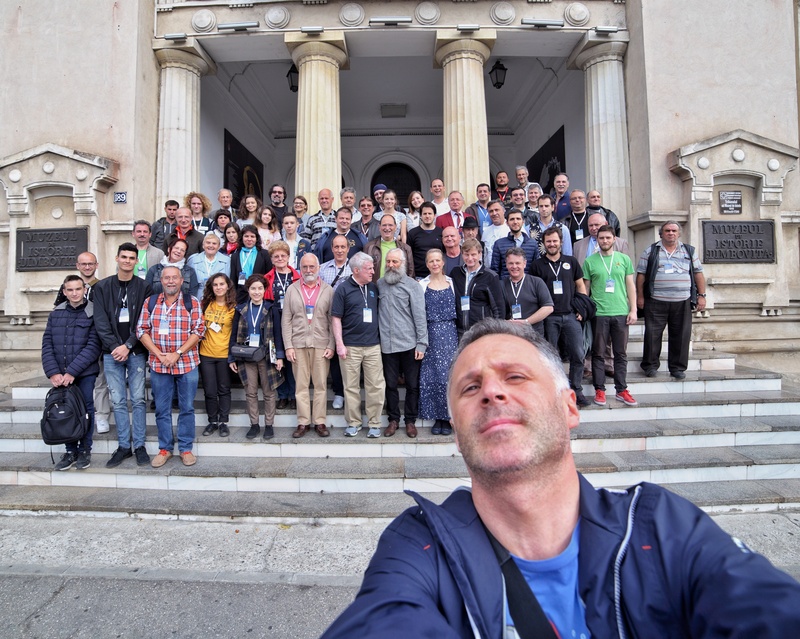
After the show,
George Tanase returned to the central square
for a few other photos.
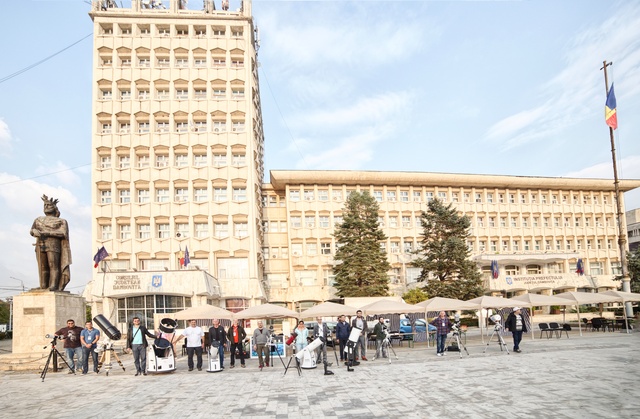
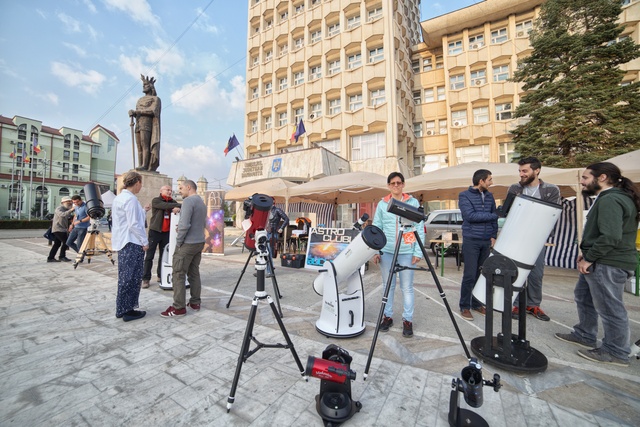
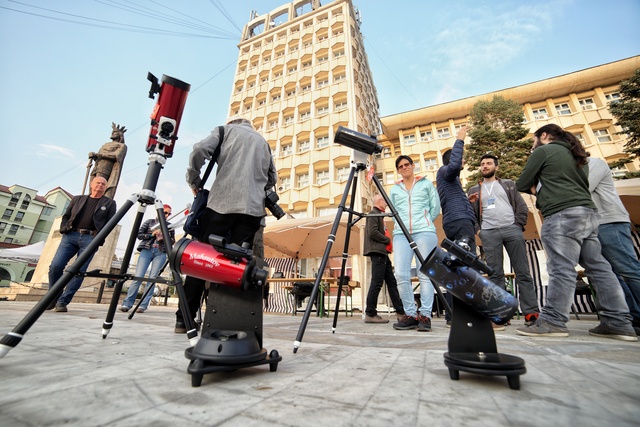
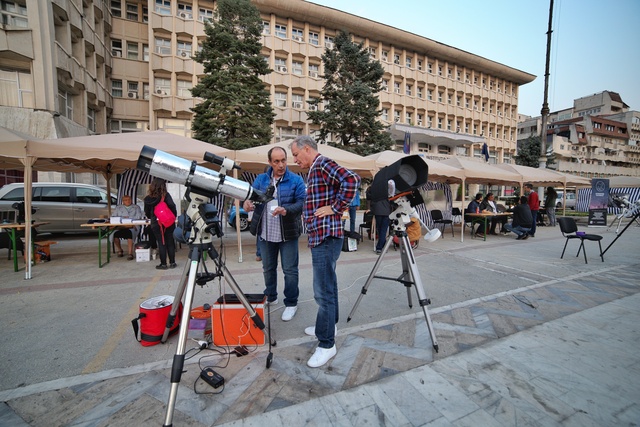
I continued with photos shortly before the fall of the darkness,
with the participation of the Moon.
During that evening
George Tanase made the last cycle of photos on the open air festival:
people and telescopes, astral friendship and star costumes.
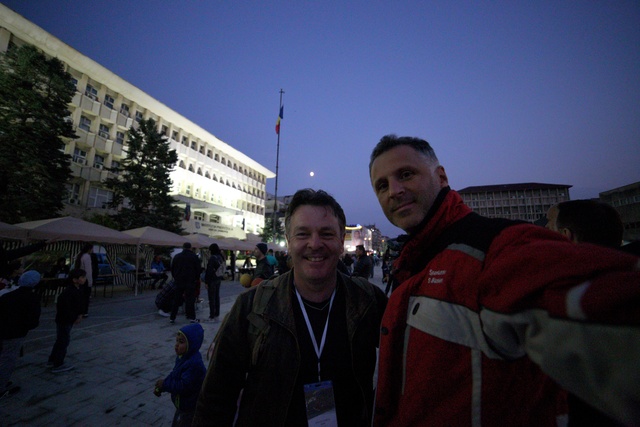
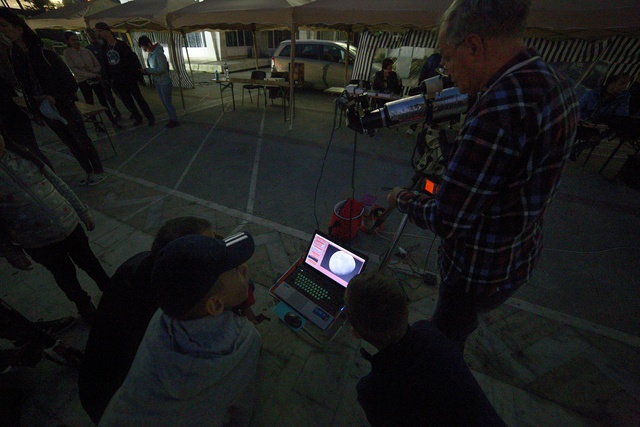
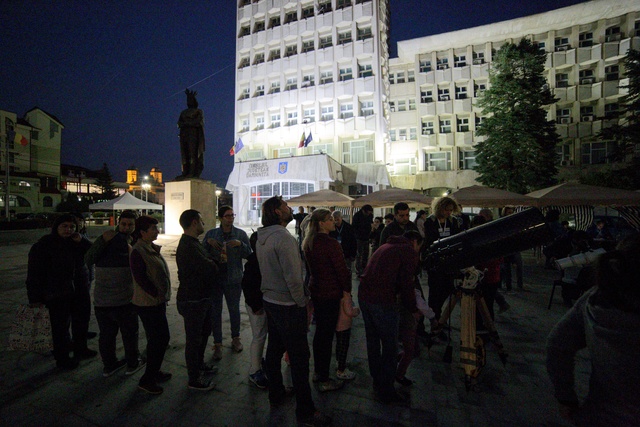
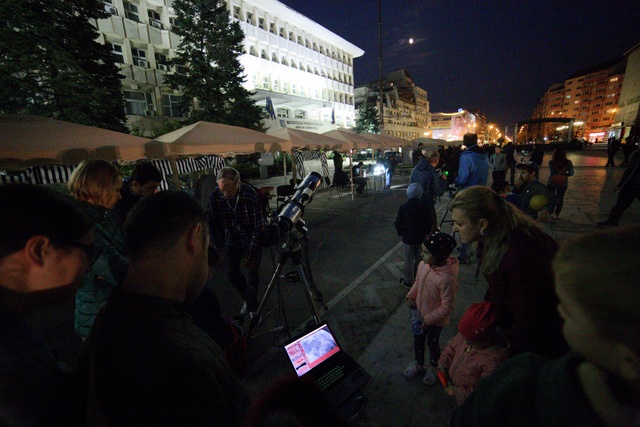
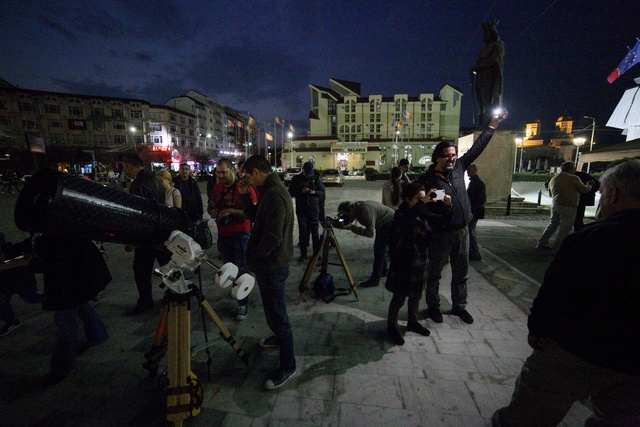
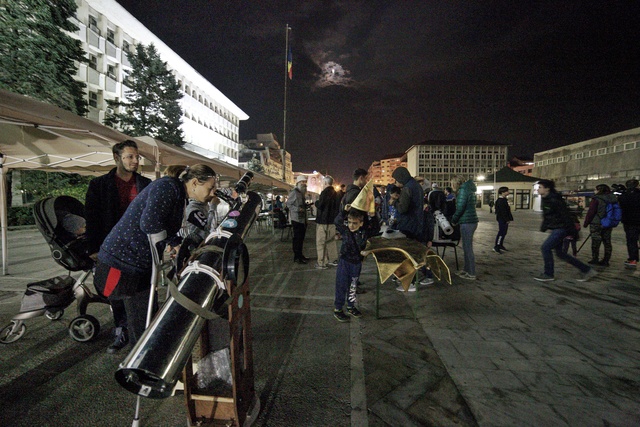
A real wonder:
the Crowned Moon and star children
at the same event
-Andrei Dorian Gheorghe-
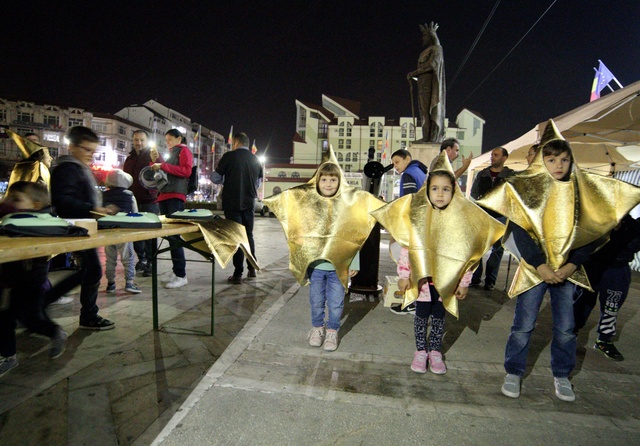
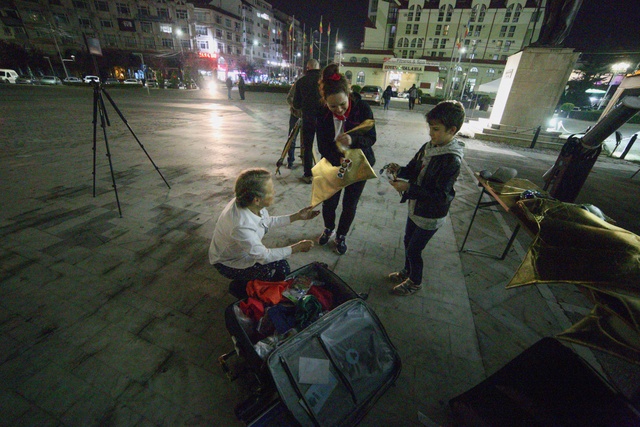
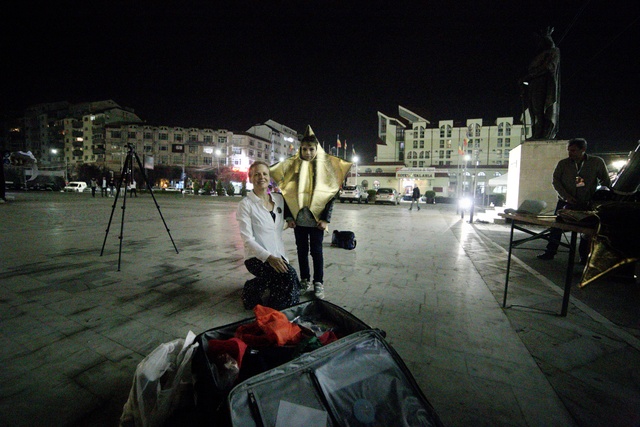
EPILOGUE
On October 21, 2018
the Romanian participants returned home,
while the foreign participants enjoyed an excursion to the Prahova Valley,
with a halt for lunch at the New Jerusalem Monastery in Pucioasa,
a special place about which Valentin Grigore and I
made an astro-haiga in April 2018.
 800.jpg)
On October 22, the foreign participants went home, too,
except for John Goldsmith, who,
together with Valentin Grigore, Cosmin Sorin Miclos and George Tanase,
went to see and photograph
the famous Sphinx of Bucegi at over 2,000 meters
(the center of a very old European civilization,
probably even from Neanderthal and Cro-Magnon times,
which remained as a sacred place of the Geto-Dacians
and is the same high with the Sphinx of Giza;
John Goldsmith’s main picture is below)…
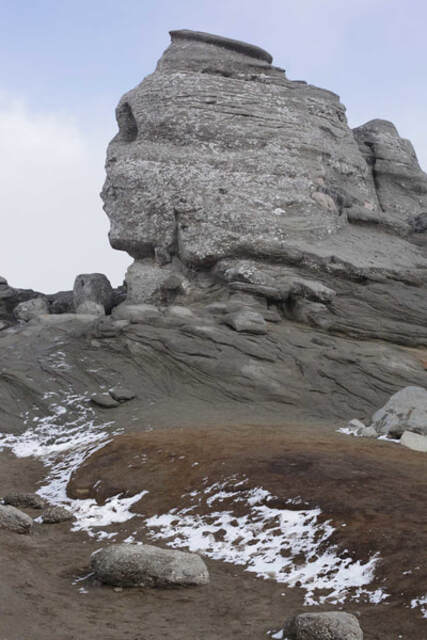
…and on the evening of October 23
they participated in an astrophotography “pilgrimage”
around Targoviste:
on the Voivodes Hill
(headquarters of SARM’s annual Perseid Event in 1993-1999,
which culminated with EuRoEclipse Perseids 99,
the largest event dedicated to the “eclipse of the 21st century”,
with participants from four continents);
and near the Priseaca Lake
(SARM’s favorite place for observations and astrophotography
in the recent years).
The pictures of this short expedition belong to George Tanase:
Mars over the Voivodes Hill;
Moon over Targoviste;
Moon over the Priseaca Lake.
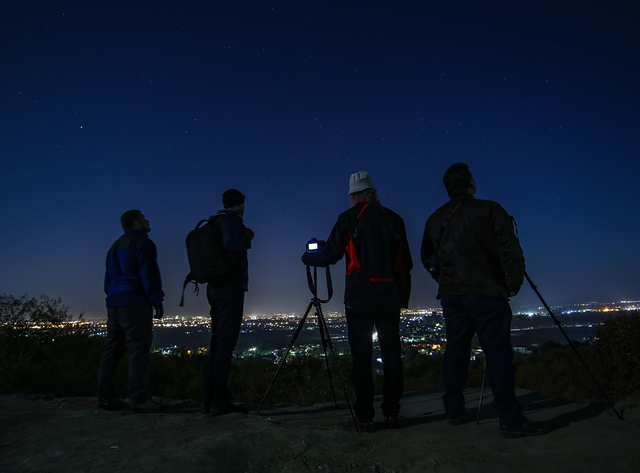
Friends in the starry sky,
Friends at the Astro-Fest,
Nobody is arrogant,
Everybody is the best.
-Andrei Dorian Gheorghe-
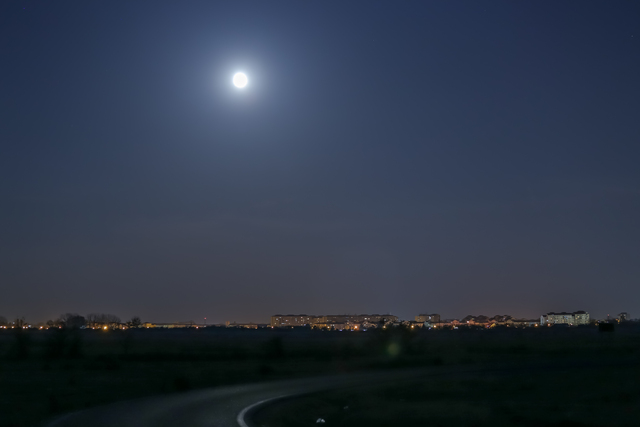
The Moon mirroring in the lake
Seems to be a significant sign:
People and stars should live together
And everything could be fine.
-Andrei Dorian Gheorghe-
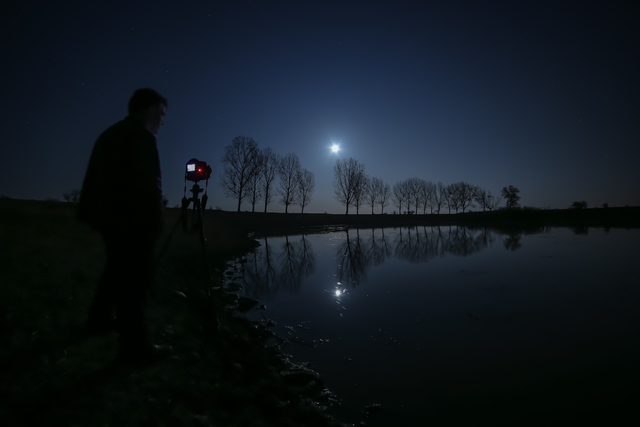
On October 24,
after the departure of the last of the participants,
Valentin Grigore discovered once again that
he wasn’t alone
and took the last two pictures of this project.
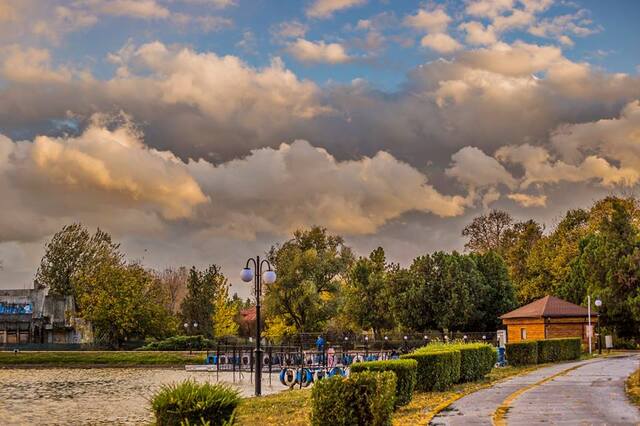
A rainbow in town
shortly after Astro-Fest -
a heavenly smile
-Andrei Dorian Gheorghe-
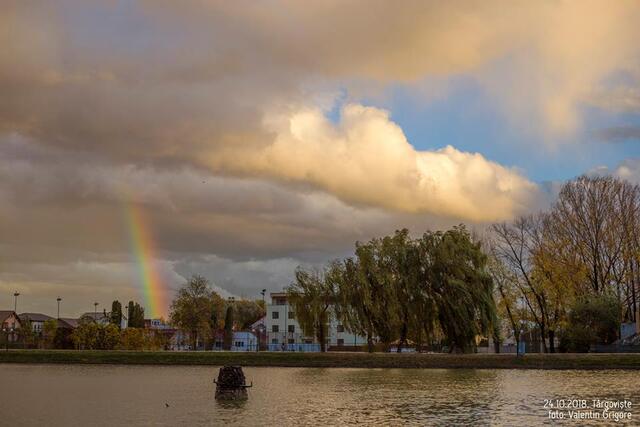
*
© 2018 SARM
(Romanian Society for Meteors and Astronomy)